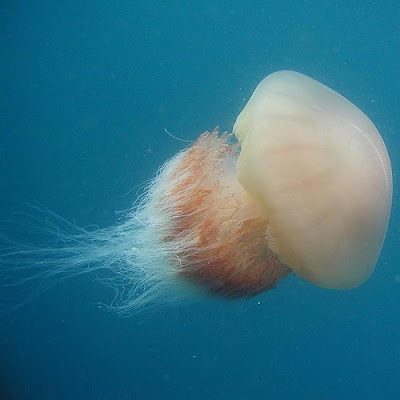Beauty Of Animal | Nomura's Jellyfish | Nomura's jellyfish is an enormous jellyfish like Lion's Mane jellyfish. Nomura's Jellyfish also known as the Echizen kurage in Japan, is a large Japanese Jellyfish whose width is slightly larger than a height of a fully grown man. Nomura's jellyfish are more commonly found in the oceans near Korea and China. Scientists think they originate in the Yellow Sea and in Chinese waters. They live in waters near Japan as well. The major areas where they can be found are East China Sea and Yellow Sea.
This massive sea creatures can grow 6 feet (1.83 meters) in diameter and weigh more than 450 pounds (204 kilos). This creature is one of the largest of the jellyfish species. Some look like they have eyes, but they don't. They also have no brain. Their bodies are at least 94% water. They also have no respiratory system. The jellyfish's mouth is also their anus. Their color is gray with pinkish brown tentacles. Their predators are swordfish, tuna, sunfish, leatherback turtles, and humans. Nomura's jellyfish eat plankton that they catch with their tentacles. This jellyfish can eat large crustaceans.
An interesting fact about the jellyfish is the way man eats them. Chinese eat them with sesame oil and onions. Vietnamese eat them with red chili peppers, in Korea with mustard, and in Thailand as a noodle. We Americans think they taste like "snot". Their population is on the rise in the fishing waters and is a serious problem to the fishermen because a large number of the Nomura's Jellyfish gets caught in their nets. The cause for greater concern is that they poison their catch with their toxic stingers or crush them to death. And often break the nets due to their weight. It's a serious crisis which has started to affect their livelihood.
There are even reports where they destroy the local fisheries with their taste for fish eggs and larvae. In some areas the density is reported to be hundred times more than normal. There are many theories that is said to be the cause of this explosion. One is global warming where the seas have been warmed and are better suited for their breeding. And scientists blame the over-fishing of the natural predators of the Jellyfish and the pollution along the coast. The high levels of nutrients in the water are also linked to this sudden jellyfish bloom.
Find Here The Kinds Of Animals and Flora and Fauna













